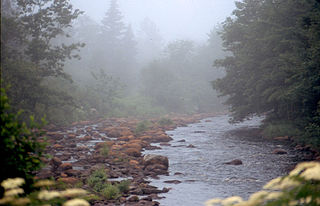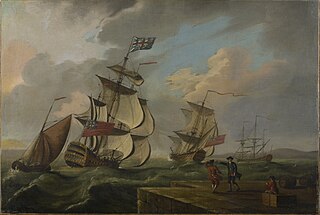East River is a community in the Canadian province of Nova Scotia, located in the Chester Municipal District on the Aspotogan Peninsula on the Lighthouse Route at the junction of (Nova Scotia Route 329) and Trunk 3.
East River is a community in the Canadian province of Nova Scotia, located in the Chester Municipal District on the Aspotogan Peninsula on the Lighthouse Route at the junction of (Nova Scotia Route 329) and Trunk 3.
The village was known as East River Point, and before that Indian Point. It got its name from the river because it is on the eastern side of Mahone Bay. 120 acres (0.49 km2) of land there reserved for John, Joseph and Thomas Paul, who were Mi’kmaq on September 3, 1793. At East River, David Floyd received a grant on August 18, 1815, and John Wheaton received in April 1817. John Booth's grant was dated September 22, 1899. (Places, p. 190) All these people are unknown.
Cook's Beach was named for Ephraim Cook a direct descendant of Francis Cook of the Mayflower. He (Ephraim) settled with his family on land in Lower Melbourne near Cooks Beach (named in his honor). He was one of the first settlers in Yarmouth.
Who the following landmarks are named after is unknown: Meisners Beach, G. Roast, L. Roast (Church Map)
Rous Point and Rous Cove is named after Captain John Rous who led the naval operations off Nova Scotia during Father Le Loutre's War. [1]

Mahone Bay is a town on the northwest shore of Mahone Bay along the South Shore of Nova Scotia in Lunenburg County. A long-standing picturesque tourism destination, the town has recently enjoyed a growing reputation as a haven for entrepreneurs and business startups. The town has the fastest growing population of any municipality in Nova Scotia according to the 2016 census, experiencing 9.9% population growth.

Liverpool is a Canadian community and former town located along the Atlantic Ocean of the Province of Nova Scotia's South Shore. It is situated within the Region of Queens Municipality which is the local governmental unit that comprises all of Queens County, Nova Scotia.

Petite Rivière is a rural community on Route 331 in Lunenburg County on the South Shore of Nova Scotia in Canada. It was formerly known as Petite Rivière Bridge.
The Isthmus of Chignecto is an isthmus bordering the Maritime provinces of New Brunswick and Nova Scotia that connects the Nova Scotia peninsula with North America.
The Aspotogan Peninsula is a peninsula in the eastern part of Lunenburg County, Nova Scotia, separating St. Margarets Bay in the east from Mahone Bay in the west. The peninsula was originally settled by second generation French immigrants on the east side and by second generation German immigrants on the west side. Traditionally fishing was a major industry for communities throughout the peninsula, however other primary industries such as farming and forestry were historically important as well. Shipping and shipbuilding were secondary and tertiary industries that also came into prominence during the 19th and early 20th centuries.
Bridgetown is a Canadian community located in north-central Annapolis County, Nova Scotia.

Point Danger is a headland, located at Coolangatta on the southern end of the Gold Coast on the east coast of Australia. Separated by Snapper Rocks and Rainbow Bay to the west, with Duranbah Beach and the Tweed River mouth to the south, present-day Point Danger has also indicated the border between New South Wales and Queensland, Australia, since 1863.

McNabs Island is the largest island in Halifax Harbour located in Halifax Regional Municipality, Nova Scotia, Canada. It played a major role in defending Halifax Harbour and is now a provincial park. The island was settled by Britons in the 1750s and later by Peter McNab, and McNab family members lived on the island until 1934.
The Lighthouse Route is a scenic roadway in the Canadian province of Nova Scotia. It follows the province's South Shore for 585 km (364 mi) from Halifax to Yarmouth.
Chebogue is a small fishing village situated above the marshes of the Chebogue River in Yarmouth County, Nova Scotia. Farming and fishing are the two main resources in the area.
Maugerville is a New Brunswick unincorporated community located on the east bank of the Saint John River in Maugerville Parish, Sunbury County, in the Canadian province of New Brunswick. The settlement is located on provincial Route 105, 16 kilometres southeast of the capital city of Fredericton and 3.18 kilometres northeast of the town of Oromocto.

The St. Croix River is a river in Nova Scotia entirely contained in Hants and Halifax Counties. Its headwaters are Panuke Lake. The river has been exploited for water power. There were water mills in the nineteenth century and in the 1930s three hydroelectric dams were built; they still operate.

John Rous was a privateer and then an officer of the Royal Navy. He served during King George's War and the French and Indian War. Rous was also the senior naval officer on the Nova Scotia station during Father Le Loutre's War (1749–1755). Rous' daughter Mary married Richard Bulkeley (governor) and is buried in the Old Burying Ground.
Blandford is a community in the Canadian province of Nova Scotia, located in the Chester Municipal District on the Aspotogan Peninsula on the Lighthouse Route. Blandford originally included the present day communities of New Harbour, Upper Blandford, and Deep Cove.
Mill Cove is a community in the Canadian province of Nova Scotia, located in the Chester Municipal District on the Aspotogan Peninsula on the Lighthouse Route. The community was home to CFS Mill Cove from 1967 til the 1990s.
Fox Point is a community in the Canadian province of Nova Scotia, located on the Aspotogan Peninsula in the Chester Municipal District on the Lighthouse Route.
Blockhouse is a community in the Canadian province of Nova Scotia, located in the Lunenburg Municipal District in Lunenburg County. It was named after the blockhouses constructed by Captain Ephraim Cook to protect colonists following a raid in 1756. The final blockhouse in the community burned down in 1874.

The Devils Island Light is a Nova Scotia lighthouse located at the eastern shore entrance to Halifax Harbour on Devils Island, Nova Scotia. First lit in 1852, it was succeeded by a second lighthouse in 1877 which survives today. The lighthouse has influenced regional folklore and remains an important community landmark although it is currently neglected and threatened.

Silvanus Cobb was a Massachusetts provincial army captain and later naval commander who fought for the British primarily in Nova Scotia in the 1740s and 1750s.

Ephraim Cook (Cooke) was a mariner and prominent merchant who was instrumental in establishing Halifax, Mahone Bay, Blockhouse and Chebogue, Nova Scotia. He also participated in the French and Indian War, including the Expulsion of the Acadians. He was the first Registrar of Deeds (1767) and the first Justice of the Peace in Yarmouth County.
Coordinates: 44°35′11″N64°9′59″W / 44.58639°N 64.16639°W